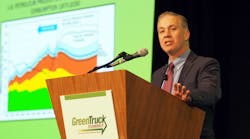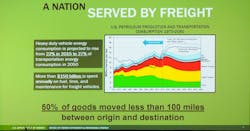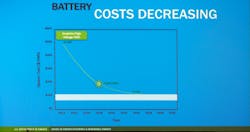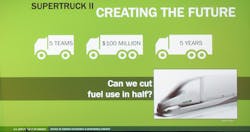INDIANAPOLIS. Those on the inside of trucking and freight movement have seen the changes happening in transportation, many of them relating to new technologies and how businesses are evolving and learning to use them. But look from the opposite direction to understand why — and how — all these changes are coming (and accelerating).
It's real, changing needs and dramatically different transportation problems that have come about, and these are the attempts to solve them.
Michael Berube, acting deputy assistant secretary for sustainable energy efficiency and renewable energy at the U.S. Dept. of Energy, spoke at Green Truck Summit 2019 about the backdrop of issues and ultimately how the tools that fleets and trucking companies use and the ways they do their work are being altered — business models, software and connectivity systems, even the trucks and other hardware for the job.
It's obvious that there has been and continues to be a major shift condensing the population into metro/ urban areas, driven in large part by people moving toward economic opportunity. That has brought much more density and vehicle volume (translation: congestion) precisely where transportation needs are greatest, and e-commerce advancements and convenience have set shipping and transport expectations very high even as more goods are then transported to people vs. people going to get them themselves.
So the obvious result of all that is that today, there are many more trucks on the road to handle transportation/ shipping needs right where there is no room for more vehicles, and pollution and fuel burn from those vehicles quickly reaches intolerable levels unlike what's been dealt with before.
Meanwhile, the vast majority of cars on the road carry one passenger, and transportation/ vehicle costs are the second-highest household expense, soaking up some 20-30% of net income for an asset that sits around unused 95% of the time, Berube pointed out. Seems to beg some big questions along the lines of "why are we doing it this way," and the same thing is happening for freight and commercial transport.
"When you look at freight — we [at DOE] do a lot of looking at the details of freight movement — what happens? What are the business models?" Berube said. Half of goods by weight move less than 100 miles from origin to destination in the U.S., he explained, and fully three-quarters of freight moves less than 250 miles.
So looking at the roadways today, DOE sees several areas where the present compounding difficulties might be eased. Berube pointed out the powerful incongruity of an industry decrying it is short 50,000 truck drivers and counting as of last year even as the American Transportation Research Institute has just calculated that congestion now costs trucking companies 1.2 billion productivity hours annually, or the equivalent of 425,000 truck drivers sitting idle all year long.
DOE takes a practical approach, given its authority: help change the vehicles and ways of doing business to work better within the existing infrastructure instead of approaching the problem only from the other end and trying to undertake all the massive, very costly efforts to bring the existing infrastructure up to the completely different needs that have come about since it was built.
Fully electric trucks could be a large part of the urban/ metro-area transportation and distribution solution, DOE believes. Berube pointed out that this year at Green Truck Summit, much of the attention was on fully battery-electric vehicles vs. the lesser hybrid-type approaches to electrifying trucks in the spotlight only a handful of years ago.
DOE, which is a (if not the) global authority on battery research and advancing that technology, has a big hand in that and channels some $110 million in taxpayer dollars annually into this effort alone. Batteries in vehicles have reached a capacity and cost point where for light-duty vehicles at least, electric cars are getting closer to even with internal combustion engine vehicles, Berube noted.
More will be developing on that front, he added, but DOE is also now funding half of a $36 million project to demonstrate a complete business model for electric trucking. "We will demonstrate battery-electric freight electrification including charging, including vehicles and the entire systems-level look," he said.
DOE continues its work on internal combustion engine vehicles as well. For the long-haul side of trucking, DOE's SuperTruck II program is about halfway through, and Berube noted the goal there is to double fuel efficiency of heavy trucks.
"Can we cut fuel use in half in Class 8 long-haul trucks? That's pretty amazing savings — a 100% overall improvement in freight efficiency," Berube noted. "There are five teams and it's a $100 million effort over five years."
In real terms, that program will lead to trucks that are streamlined, even more technologically advanced, and overall quite different than the vehicles that trucking companies used even just 10 years ago.
With those and its other efforts on the U.S. energy scene as it relates to transportation and freight, "we believe that through investments and research and collaboration with the industry, we can have more choices that are more affordable, that are more efficient, that ultimately provide people and companies with the options they need, when and where they need them," Berube said.
"Ultimately," he added, "that's what it will take to move the needle forward across all the challenges that we have."






